The winners of The London’s Natural History Museum's prestigious Wildlife Photographer of the Year for 2013 have finally been unveiled. Selected from almost 43,000 entries from 96 countries, the winners offer a glimpse of the stunning array of natural beauty on our planet.

Canada: “Lucky pounce”. “Anticipating the pounce – that was the hardest part”, says Connor, who had come to Yellowstone National Park, Wyoming, USA, in search of wildlife as much as the spectacular landscape. He had found this fox, his first ever, on his last day in the park. It was so absorbed in hunting that Connor had plenty of time to get out of the car and settle behind a rock. It quartered the grassland, back and forth, and then started staring intently at a patch of ground, giving Connor just enough warning of the action to come. When it sprung up, Connor got his shot. And when it landed, the fox got his mouse. (Photo by Connor Stefanison/Wildlife Photographer of the Year 2013)
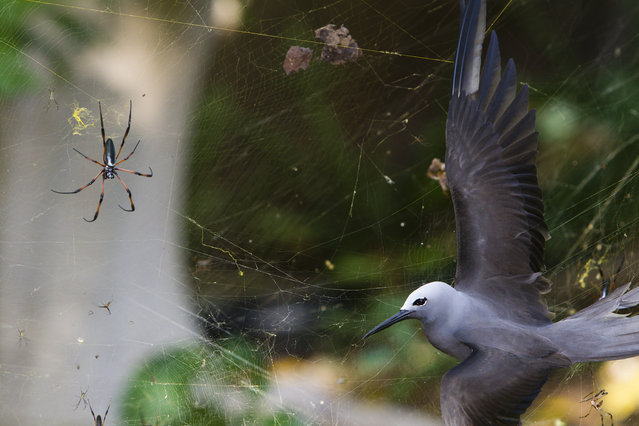
South Africa: “Sticky situation”. In May, the seafaring lesser noddies head for land to breed. Their arrival on the tiny island of Cousine in the Seychelles coincides with peak web size for the red-legged golden orb-web spiders. The female spiders, which can grow to the size of a hand, create colossal conjoined webs up to 1.5 metres in diameter in which the tiny males gather. These are woven from extremely strong silk and are suspended up to six metres above the ground, high enough to catch passing bats and birds, though it’s flying insects that the spiders are after. Noddies regularly fly into the webs. Even if they struggle free, the silk clogs up their feathers so they can’t fly. (Photo by Isak Pretorius/Wildlife Photographer of the Year 2013)
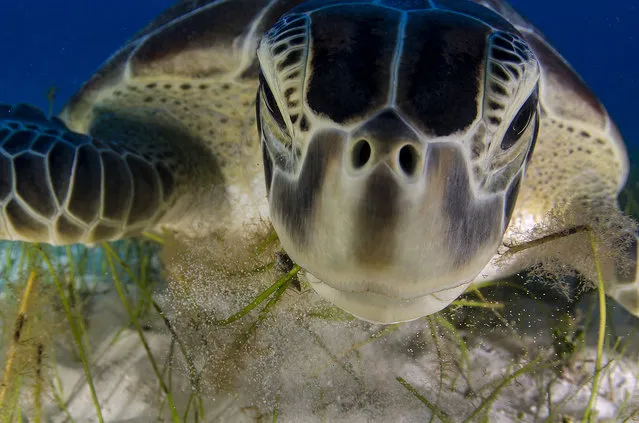
Mexico: “Dive buddy”. The beaches of the Yucatan Peninsula, Mexico, near Cancún are traditional nesting sites for the endangered green turtle. But as Cancún has also grown as a holiday and dive resort, development has reduced the area available to turtles. Today, though, many nest sites are protected, there are turtle hatcheries to help numbers increase, and there is publicity to help local people and resort owners value the natural riches of the region. Luis earns enough from tourism photography to allow him time to document his beloved wildlife. (Photo by Luis Javier Sandoval/Wildlife Photographer of the Year 2013)
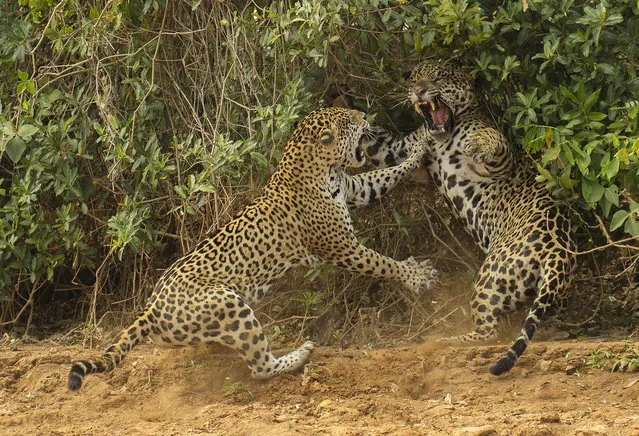
USA: “The spat”. For several hours, the noisy sounds of courtship and mating were all Joe was treated to as he sat, sweltering in the hot sun, in a boat on the Three Brothers River in Brazil’s Pantanal. So when the female jaguar finally emerged from the undergrowth and walked down to the river to drink, Joe was grateful for the photo opportunity. But that was just a start. After slaking her thirst, the female flopped down on the sand. Then the male appeared. After drinking and scent-marking, he approached the female, who was lying in what appeared to be a pose of enticement. At least, that’s what both Joe and the male thought. She rose, growled and suddenly charged, slamming the male back as he reared up to avoid her outstretched claws. (Photo by Joe McDonald/Wildlife Photographer of the Year 2013)
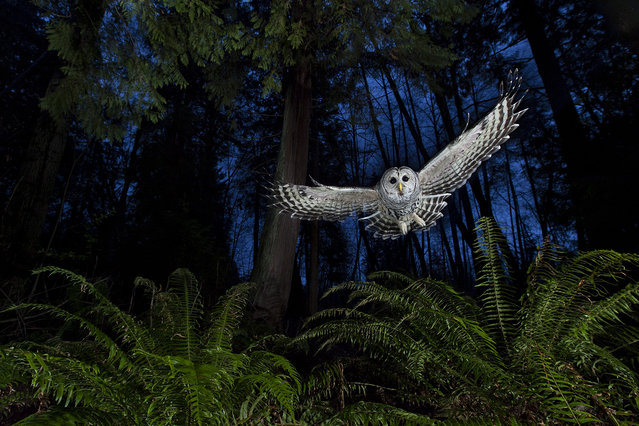
Canada: “The flight path”. This female barred owl had a territory near his home in Burnaby, British Columbia. He watched her for some time, familiarising himself with her flight paths until he knew her well enough to set up the shot. “I wanted to include the western red cedar and the sword ferns so typical of this Pacific coastal rainforest”. Setting up his camera near one of the owl’s favourite perches, linked to a remote and three off-camera flashes, diffused and on low settings, he put a dead mouse on a platform above the camera and waited for the swoop that he knew would come. (Photo by Connor Stefanison/Wildlife Photographer of the Year 2013)
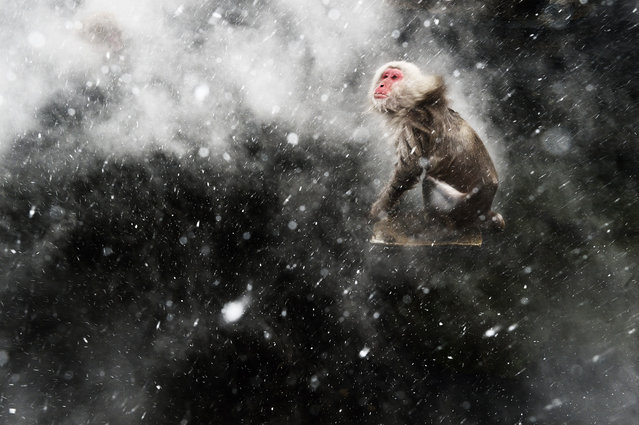
The Netherlands: “Snow moment”. When photographing the famous Japanese macaques around the hot springs of Jigokudani, central Japan, Jasper had become fascinated by the surreal effects created by the arrival of a cold wind. Occasionally, a blast would blow through the steam rising off the pools. If it was snowing, the result would be a mesmerising pattern of swirling steam and snowflakes, which would whirl around any macaques warming up in the pools. But capturing the moment required total luck – for Jasper to be there when the wind blew and for the monkeys to be in the pool. For that luck to arrive, he had to wait another year. Returning the next winter, he determined to get the shot he’d been obsessing about. He set up using a polariser to remove reflections from the water and create a dark contrasting background, and got ready to use fill-flash to catch the snowflakes. (Photo by Jasper Doest/Wildlife Photographer of the Year 2013)
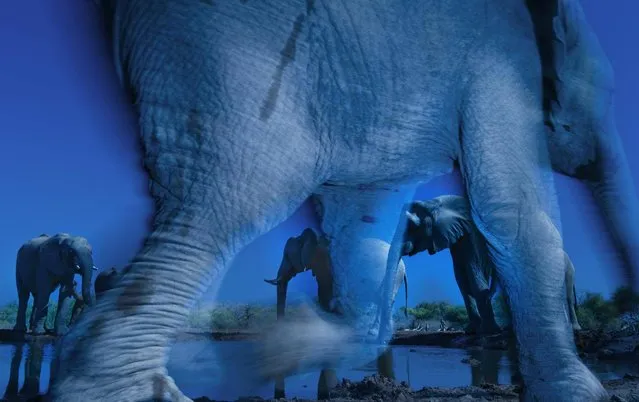
South Africa: “Essence of elephants”. Beating almost 43,000 other entries from across 96 countries, Greg’s image will take center stage at the exhibition, opening at the London’s Natural History Museum on 18 October. (Photo by Greg du Toit/Wildlife Photographer of the Year 2013)
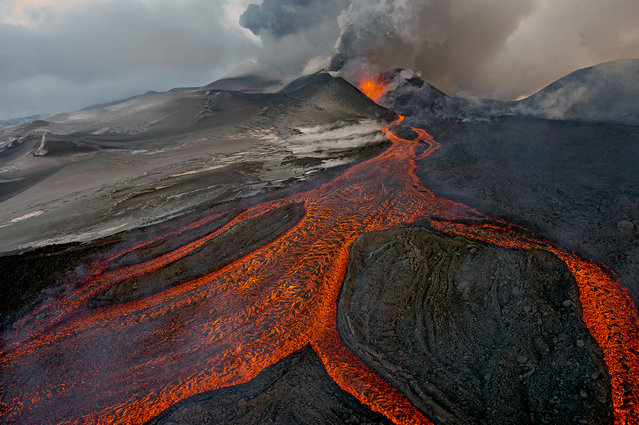
Russia: “The cauldron”. On 29 November 2012, Sergey received the call that he had long hoped for. Plosky Tolbachik – one of two volcanoes in the Tolbachik volcanic plateau in central Kamchatka, Russia – had begun to erupt. “I’ve gone to the area many times, but it had been 36 years since the last eruption”, he says. “So I dropped everything and went”. (Photo by Sergey Gorshkov/Wildlife Photographer of the Year 2013)
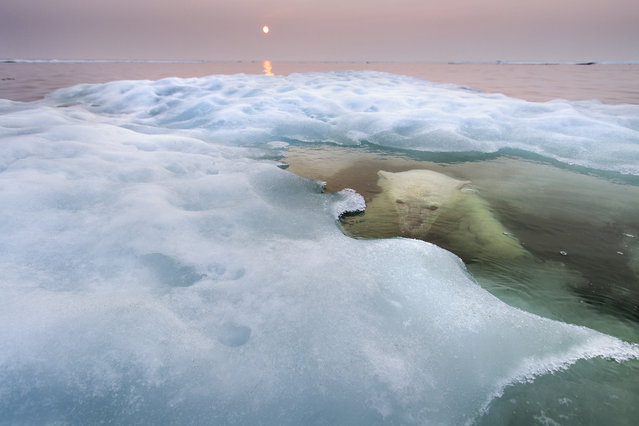
USA: “The water bear”. Paul took his Zodiac boat to Hudson Bay, Canada, in midsummer. He scouted for three days before he spotted a bear, this young female, on sea ice some 30 miles offshore. “I approached her very, very slowly”, he says, “and then drifted. It was a cat-and-mouse game”. When the bear slipped into the water, he just waited. “There was just a flat, world of water and ice and this polar bear swimming lazily around me. I could hear her slow, regular breathing as she watched me below the surface or the exhalation as she surfaced, increasingly curious. It was very special”. The light was also special, but for a sinister reason. The midnight sun was filtered through smoke from forest fires raging farther south, a symptom of the warming Arctic – the greatest threat facing the polar bear. As more and more sea ice melts earlier and earlier every spring, it becomes harder for the bears to hunt the seals they depend on. (Photo by Paul Souders/Wildlife Photographer of the Year 2013)
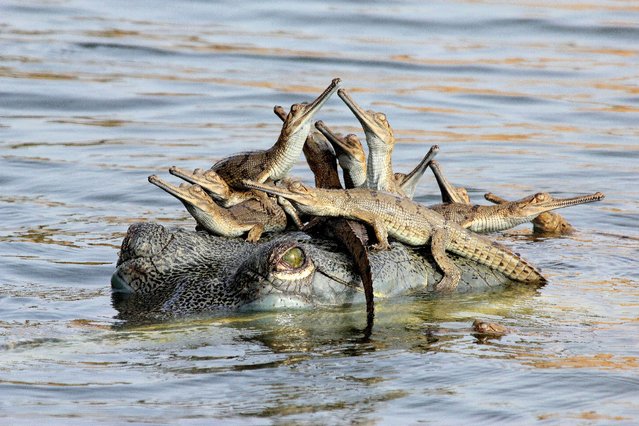
“Mother’s little headful”. Fourteen-year-old photographer Udayan Rao Pawar has also been recognised as Young Wildlife Photographer of the Year 2013 for his image Mother’s little headful. This presents an arresting scene of gharial crocodiles on the banks of the Chambal River in Madhya Pradesh, India, an area increasingly under threat from illegal sand mining and fishing. (Photo by Udayan Rao Pawar/Wildlife Photographer of the Year 2013)
17 Oct 2013 08:12:00,
post received
0 comments
